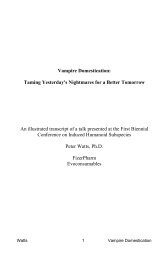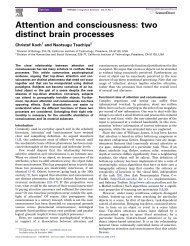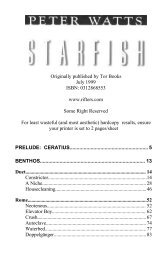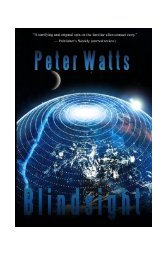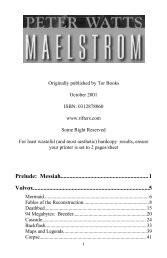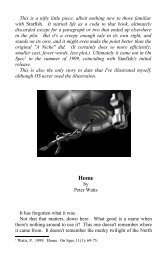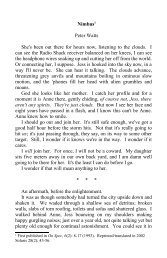You also want an ePaper? Increase the reach of your titles
YUMPU automatically turns print PDFs into web optimized ePapers that Google loves.
<strong>Peter</strong> <strong>Watts</strong> 9 <strong>The</strong> <strong>Island</strong><br />
nature has any right to be.<br />
For the first time in millennia, I miss my cortical pipe. It takes<br />
forever to saccade search terms onto the keyboard in my head, to<br />
get the answers I already know.<br />
Numbers come back. "Chimp. I want false-color peaks at 335,<br />
500 and 800 nanometers."<br />
<strong>The</strong> shroud around 428 lights up like a dragonfly's wing, like an<br />
iridescent soap bubble.<br />
"It's beautiful," whispers my awestruck son.<br />
"It's photosynthetic," I tell him.<br />
Phaeophytin and eumelanin, according to spectro. <strong>The</strong>re are<br />
even hints of some kind of lead-based Keipper pigment, soaking<br />
up X-rays in the picometer range. Chimp hypothesizes something<br />
called a chromatophore: branching cells with little aliquots of<br />
pigment inside, like particles of charcoal dust. Keep those particles<br />
clumped together and the cell's effectively transparent; spread<br />
them out through the cytoplasm and the whole structure darkens,<br />
dims whatever EM passes through from behind. Apparently there<br />
were animals back on Earth with cells like that. <strong>The</strong>y could<br />
change color, pattern-match to their background, all sorts of things.<br />
"So there's a membrane of— of living tissue around that star," I<br />
say, trying to wrap my head around the concept. "A, a meat<br />
balloon. Around the whole damn star."<br />
"Yes," the chimp says.<br />
"But that's— Jesus, how thick would it be?"<br />
"No more than two millimeters. Probably less."<br />
"How so?"<br />
"If it was much thicker, it would be more obvious in the visible<br />
spectrum. It would have had a detectable effect on the von<br />
Neumanns when they hit it."<br />
"That's assuming that its— cells, I guess— are like ours."<br />
"<strong>The</strong> pigments are familiar; the rest might be too."<br />
It can't be too familiar. Nothing like a conventional gene would<br />
last two seconds in that environment. Not to mention whatever<br />
*



